Analyzing the Impact of Job Design on Employee Performance
VerifiedAdded on 2021/06/14
|8
|2310
|203
Essay
AI Summary
This essay examines the multifaceted impact of job design on employees within the context of evolving global business environments. It begins by defining job design and its significance in aligning organizational and employee needs, introducing methods like job rotation, enlargement, enrichment, and simplification. The essay then presents a balanced analysis of differing viewpoints. Some argue that job design primarily benefits employers through increased efficiency, while others assert its potential to enhance employee motivation, skill development, and job satisfaction. The discussion includes critical analysis of the benefits and drawbacks of each job design method, referencing socio-technical systems, work reform, and motivational work designs. The essay concludes by highlighting the importance of balancing organizational goals with employee needs to foster a positive work environment and maximize productivity.
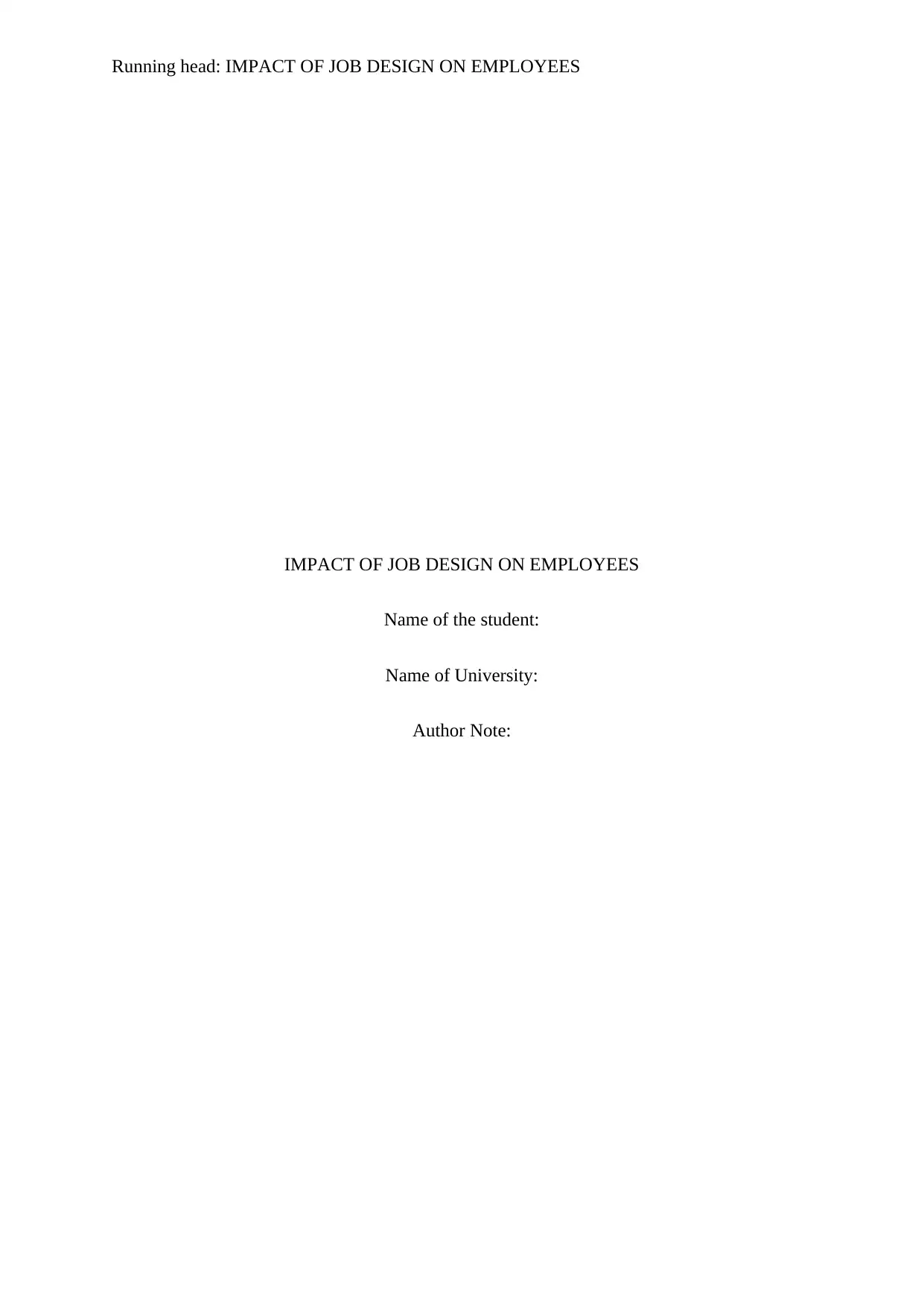
Running head: IMPACT OF JOB DESIGN ON EMPLOYEES
IMPACT OF JOB DESIGN ON EMPLOYEES
Name of the student:
Name of University:
Author Note:
IMPACT OF JOB DESIGN ON EMPLOYEES
Name of the student:
Name of University:
Author Note:
Paraphrase This Document
Need a fresh take? Get an instant paraphrase of this document with our AI Paraphraser
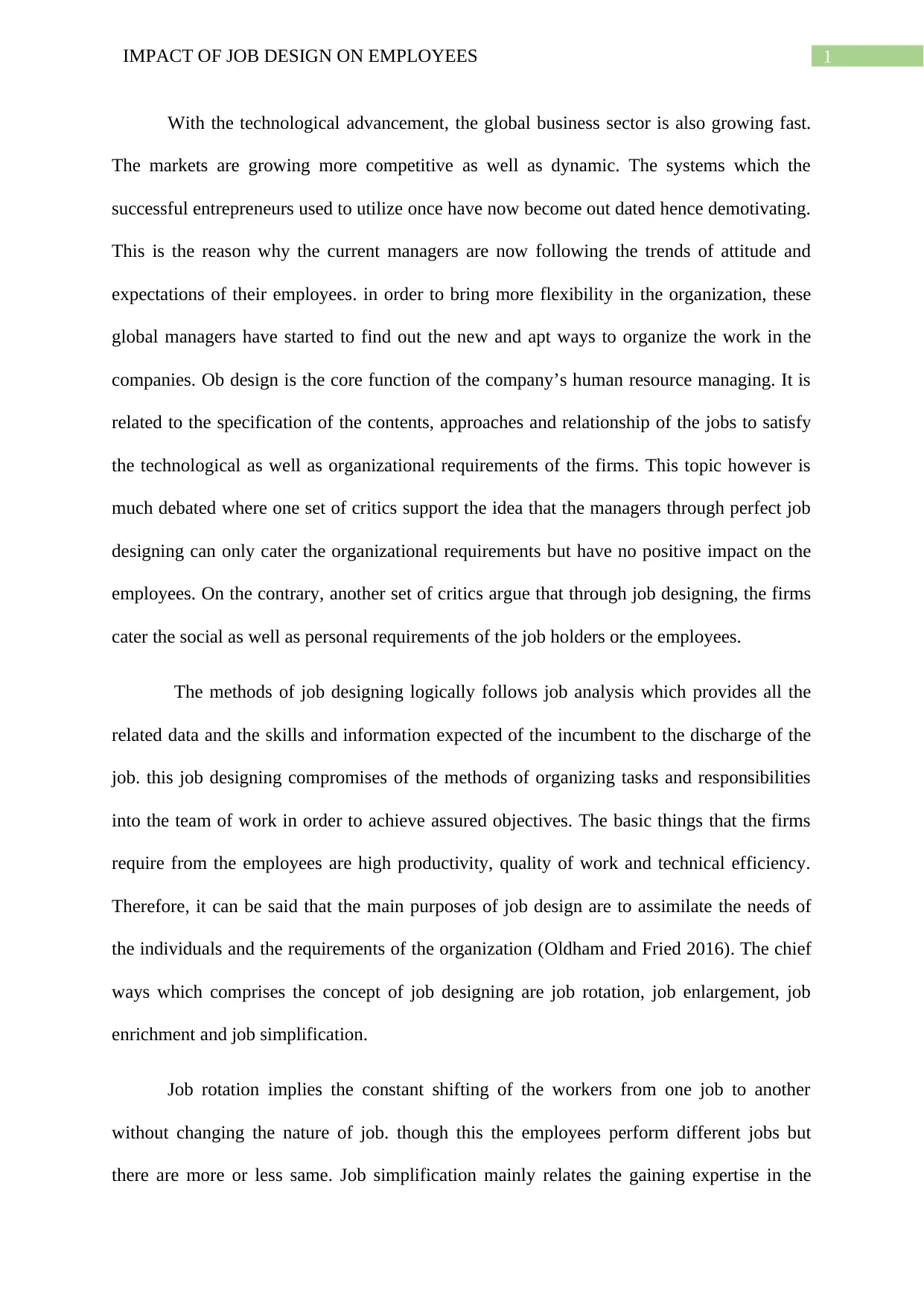
1IMPACT OF JOB DESIGN ON EMPLOYEES
With the technological advancement, the global business sector is also growing fast.
The markets are growing more competitive as well as dynamic. The systems which the
successful entrepreneurs used to utilize once have now become out dated hence demotivating.
This is the reason why the current managers are now following the trends of attitude and
expectations of their employees. in order to bring more flexibility in the organization, these
global managers have started to find out the new and apt ways to organize the work in the
companies. Ob design is the core function of the company’s human resource managing. It is
related to the specification of the contents, approaches and relationship of the jobs to satisfy
the technological as well as organizational requirements of the firms. This topic however is
much debated where one set of critics support the idea that the managers through perfect job
designing can only cater the organizational requirements but have no positive impact on the
employees. On the contrary, another set of critics argue that through job designing, the firms
cater the social as well as personal requirements of the job holders or the employees.
The methods of job designing logically follows job analysis which provides all the
related data and the skills and information expected of the incumbent to the discharge of the
job. this job designing compromises of the methods of organizing tasks and responsibilities
into the team of work in order to achieve assured objectives. The basic things that the firms
require from the employees are high productivity, quality of work and technical efficiency.
Therefore, it can be said that the main purposes of job design are to assimilate the needs of
the individuals and the requirements of the organization (Oldham and Fried 2016). The chief
ways which comprises the concept of job designing are job rotation, job enlargement, job
enrichment and job simplification.
Job rotation implies the constant shifting of the workers from one job to another
without changing the nature of job. though this the employees perform different jobs but
there are more or less same. Job simplification mainly relates the gaining expertise in the
With the technological advancement, the global business sector is also growing fast.
The markets are growing more competitive as well as dynamic. The systems which the
successful entrepreneurs used to utilize once have now become out dated hence demotivating.
This is the reason why the current managers are now following the trends of attitude and
expectations of their employees. in order to bring more flexibility in the organization, these
global managers have started to find out the new and apt ways to organize the work in the
companies. Ob design is the core function of the company’s human resource managing. It is
related to the specification of the contents, approaches and relationship of the jobs to satisfy
the technological as well as organizational requirements of the firms. This topic however is
much debated where one set of critics support the idea that the managers through perfect job
designing can only cater the organizational requirements but have no positive impact on the
employees. On the contrary, another set of critics argue that through job designing, the firms
cater the social as well as personal requirements of the job holders or the employees.
The methods of job designing logically follows job analysis which provides all the
related data and the skills and information expected of the incumbent to the discharge of the
job. this job designing compromises of the methods of organizing tasks and responsibilities
into the team of work in order to achieve assured objectives. The basic things that the firms
require from the employees are high productivity, quality of work and technical efficiency.
Therefore, it can be said that the main purposes of job design are to assimilate the needs of
the individuals and the requirements of the organization (Oldham and Fried 2016). The chief
ways which comprises the concept of job designing are job rotation, job enlargement, job
enrichment and job simplification.
Job rotation implies the constant shifting of the workers from one job to another
without changing the nature of job. though this the employees perform different jobs but
there are more or less same. Job simplification mainly relates the gaining expertise in the
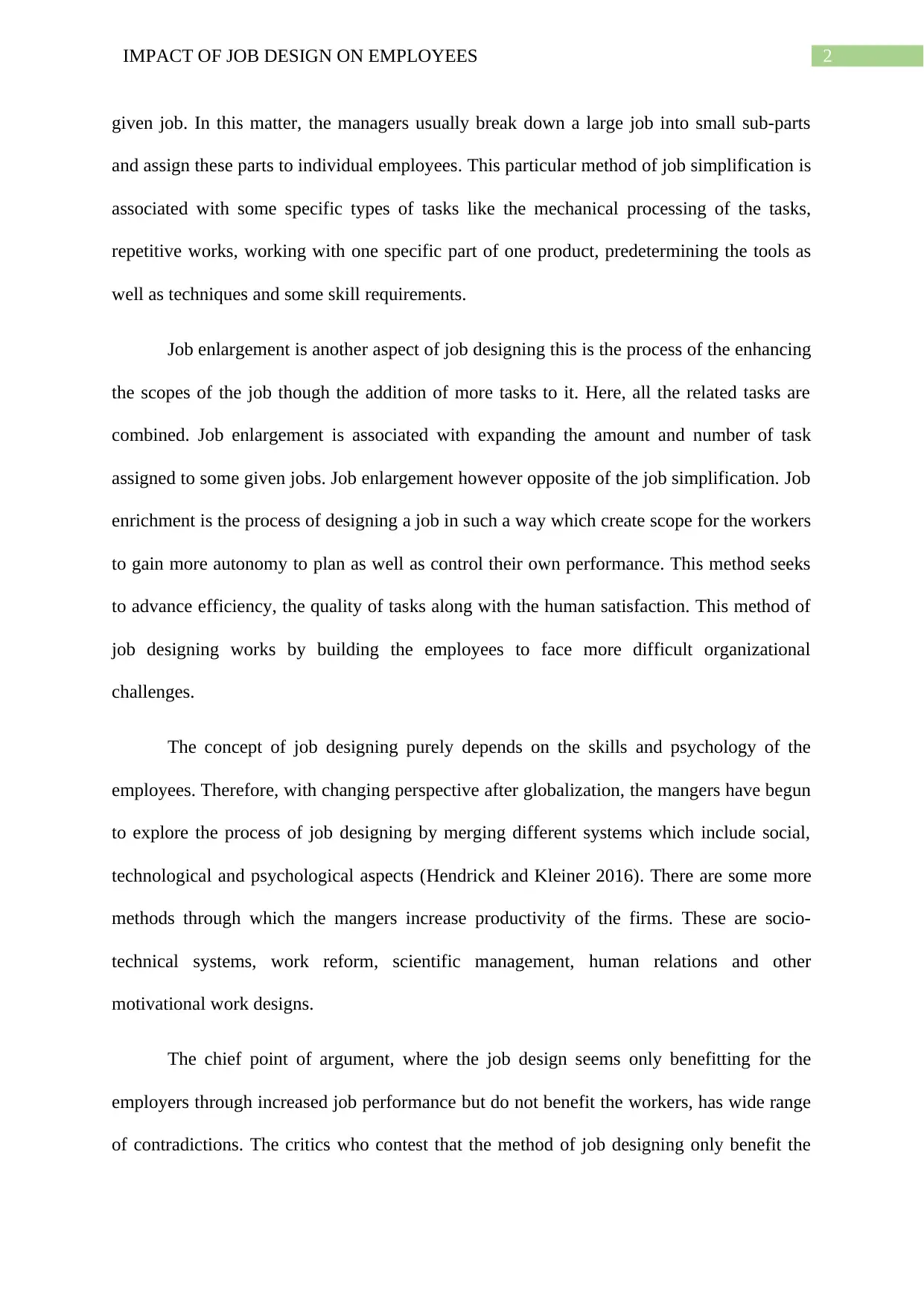
2IMPACT OF JOB DESIGN ON EMPLOYEES
given job. In this matter, the managers usually break down a large job into small sub-parts
and assign these parts to individual employees. This particular method of job simplification is
associated with some specific types of tasks like the mechanical processing of the tasks,
repetitive works, working with one specific part of one product, predetermining the tools as
well as techniques and some skill requirements.
Job enlargement is another aspect of job designing this is the process of the enhancing
the scopes of the job though the addition of more tasks to it. Here, all the related tasks are
combined. Job enlargement is associated with expanding the amount and number of task
assigned to some given jobs. Job enlargement however opposite of the job simplification. Job
enrichment is the process of designing a job in such a way which create scope for the workers
to gain more autonomy to plan as well as control their own performance. This method seeks
to advance efficiency, the quality of tasks along with the human satisfaction. This method of
job designing works by building the employees to face more difficult organizational
challenges.
The concept of job designing purely depends on the skills and psychology of the
employees. Therefore, with changing perspective after globalization, the mangers have begun
to explore the process of job designing by merging different systems which include social,
technological and psychological aspects (Hendrick and Kleiner 2016). There are some more
methods through which the mangers increase productivity of the firms. These are socio-
technical systems, work reform, scientific management, human relations and other
motivational work designs.
The chief point of argument, where the job design seems only benefitting for the
employers through increased job performance but do not benefit the workers, has wide range
of contradictions. The critics who contest that the method of job designing only benefit the
given job. In this matter, the managers usually break down a large job into small sub-parts
and assign these parts to individual employees. This particular method of job simplification is
associated with some specific types of tasks like the mechanical processing of the tasks,
repetitive works, working with one specific part of one product, predetermining the tools as
well as techniques and some skill requirements.
Job enlargement is another aspect of job designing this is the process of the enhancing
the scopes of the job though the addition of more tasks to it. Here, all the related tasks are
combined. Job enlargement is associated with expanding the amount and number of task
assigned to some given jobs. Job enlargement however opposite of the job simplification. Job
enrichment is the process of designing a job in such a way which create scope for the workers
to gain more autonomy to plan as well as control their own performance. This method seeks
to advance efficiency, the quality of tasks along with the human satisfaction. This method of
job designing works by building the employees to face more difficult organizational
challenges.
The concept of job designing purely depends on the skills and psychology of the
employees. Therefore, with changing perspective after globalization, the mangers have begun
to explore the process of job designing by merging different systems which include social,
technological and psychological aspects (Hendrick and Kleiner 2016). There are some more
methods through which the mangers increase productivity of the firms. These are socio-
technical systems, work reform, scientific management, human relations and other
motivational work designs.
The chief point of argument, where the job design seems only benefitting for the
employers through increased job performance but do not benefit the workers, has wide range
of contradictions. The critics who contest that the method of job designing only benefit the
⊘ This is a preview!⊘
Do you want full access?
Subscribe today to unlock all pages.

Trusted by 1+ million students worldwide
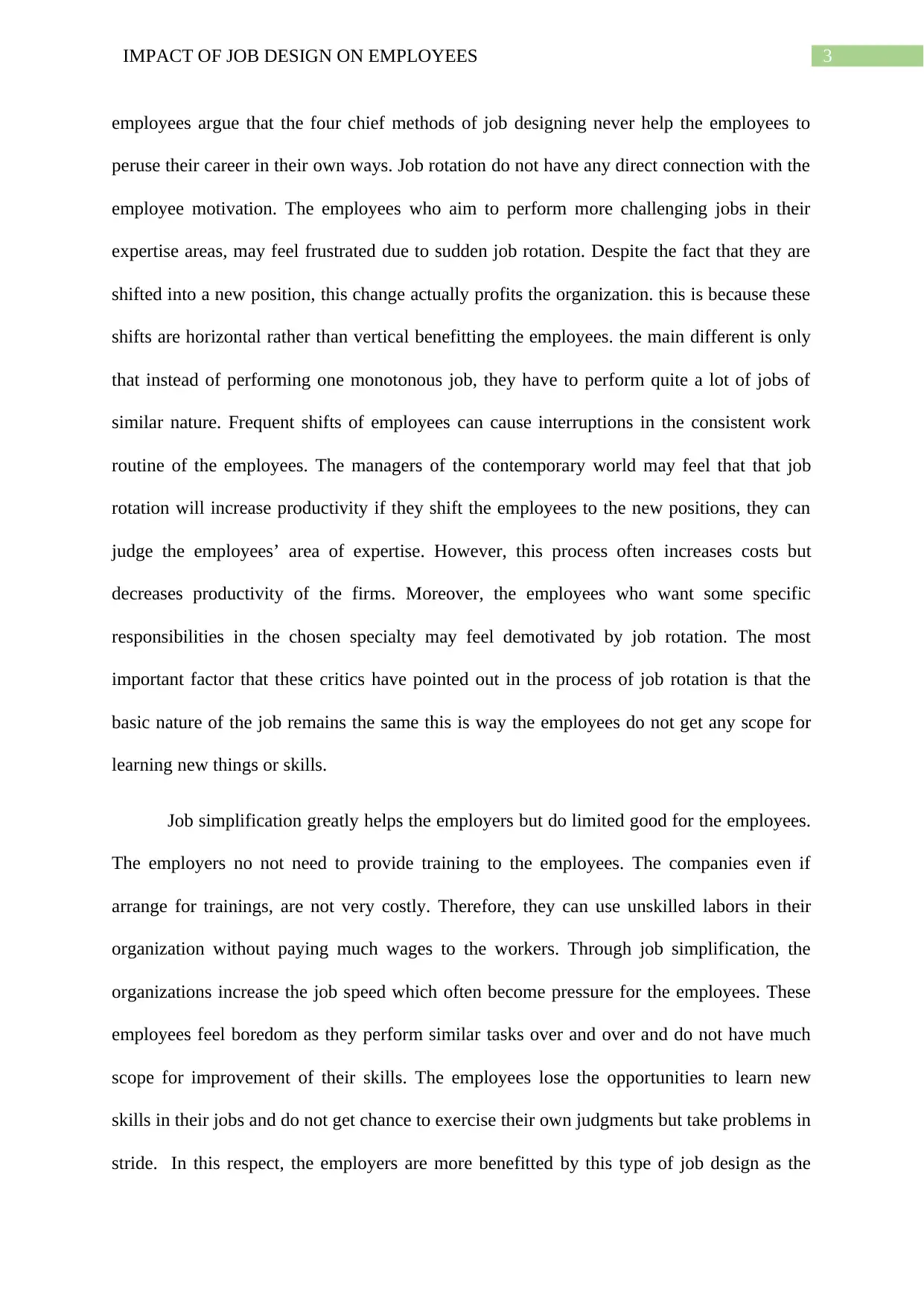
3IMPACT OF JOB DESIGN ON EMPLOYEES
employees argue that the four chief methods of job designing never help the employees to
peruse their career in their own ways. Job rotation do not have any direct connection with the
employee motivation. The employees who aim to perform more challenging jobs in their
expertise areas, may feel frustrated due to sudden job rotation. Despite the fact that they are
shifted into a new position, this change actually profits the organization. this is because these
shifts are horizontal rather than vertical benefitting the employees. the main different is only
that instead of performing one monotonous job, they have to perform quite a lot of jobs of
similar nature. Frequent shifts of employees can cause interruptions in the consistent work
routine of the employees. The managers of the contemporary world may feel that that job
rotation will increase productivity if they shift the employees to the new positions, they can
judge the employees’ area of expertise. However, this process often increases costs but
decreases productivity of the firms. Moreover, the employees who want some specific
responsibilities in the chosen specialty may feel demotivated by job rotation. The most
important factor that these critics have pointed out in the process of job rotation is that the
basic nature of the job remains the same this is way the employees do not get any scope for
learning new things or skills.
Job simplification greatly helps the employers but do limited good for the employees.
The employers no not need to provide training to the employees. The companies even if
arrange for trainings, are not very costly. Therefore, they can use unskilled labors in their
organization without paying much wages to the workers. Through job simplification, the
organizations increase the job speed which often become pressure for the employees. These
employees feel boredom as they perform similar tasks over and over and do not have much
scope for improvement of their skills. The employees lose the opportunities to learn new
skills in their jobs and do not get chance to exercise their own judgments but take problems in
stride. In this respect, the employers are more benefitted by this type of job design as the
employees argue that the four chief methods of job designing never help the employees to
peruse their career in their own ways. Job rotation do not have any direct connection with the
employee motivation. The employees who aim to perform more challenging jobs in their
expertise areas, may feel frustrated due to sudden job rotation. Despite the fact that they are
shifted into a new position, this change actually profits the organization. this is because these
shifts are horizontal rather than vertical benefitting the employees. the main different is only
that instead of performing one monotonous job, they have to perform quite a lot of jobs of
similar nature. Frequent shifts of employees can cause interruptions in the consistent work
routine of the employees. The managers of the contemporary world may feel that that job
rotation will increase productivity if they shift the employees to the new positions, they can
judge the employees’ area of expertise. However, this process often increases costs but
decreases productivity of the firms. Moreover, the employees who want some specific
responsibilities in the chosen specialty may feel demotivated by job rotation. The most
important factor that these critics have pointed out in the process of job rotation is that the
basic nature of the job remains the same this is way the employees do not get any scope for
learning new things or skills.
Job simplification greatly helps the employers but do limited good for the employees.
The employers no not need to provide training to the employees. The companies even if
arrange for trainings, are not very costly. Therefore, they can use unskilled labors in their
organization without paying much wages to the workers. Through job simplification, the
organizations increase the job speed which often become pressure for the employees. These
employees feel boredom as they perform similar tasks over and over and do not have much
scope for improvement of their skills. The employees lose the opportunities to learn new
skills in their jobs and do not get chance to exercise their own judgments but take problems in
stride. In this respect, the employers are more benefitted by this type of job design as the
Paraphrase This Document
Need a fresh take? Get an instant paraphrase of this document with our AI Paraphraser
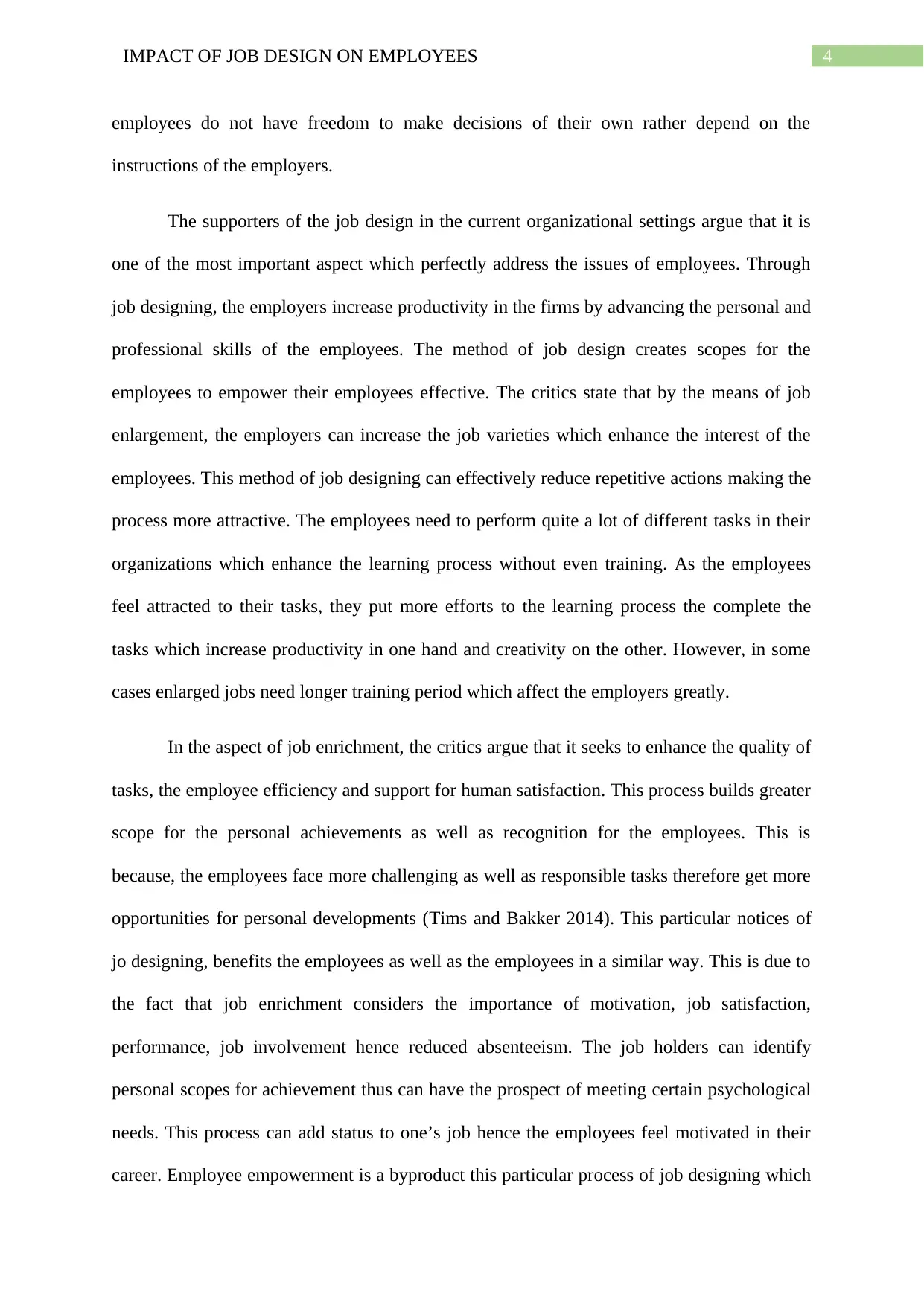
4IMPACT OF JOB DESIGN ON EMPLOYEES
employees do not have freedom to make decisions of their own rather depend on the
instructions of the employers.
The supporters of the job design in the current organizational settings argue that it is
one of the most important aspect which perfectly address the issues of employees. Through
job designing, the employers increase productivity in the firms by advancing the personal and
professional skills of the employees. The method of job design creates scopes for the
employees to empower their employees effective. The critics state that by the means of job
enlargement, the employers can increase the job varieties which enhance the interest of the
employees. This method of job designing can effectively reduce repetitive actions making the
process more attractive. The employees need to perform quite a lot of different tasks in their
organizations which enhance the learning process without even training. As the employees
feel attracted to their tasks, they put more efforts to the learning process the complete the
tasks which increase productivity in one hand and creativity on the other. However, in some
cases enlarged jobs need longer training period which affect the employers greatly.
In the aspect of job enrichment, the critics argue that it seeks to enhance the quality of
tasks, the employee efficiency and support for human satisfaction. This process builds greater
scope for the personal achievements as well as recognition for the employees. This is
because, the employees face more challenging as well as responsible tasks therefore get more
opportunities for personal developments (Tims and Bakker 2014). This particular notices of
jo designing, benefits the employees as well as the employees in a similar way. This is due to
the fact that job enrichment considers the importance of motivation, job satisfaction,
performance, job involvement hence reduced absenteeism. The job holders can identify
personal scopes for achievement thus can have the prospect of meeting certain psychological
needs. This process can add status to one’s job hence the employees feel motivated in their
career. Employee empowerment is a byproduct this particular process of job designing which
employees do not have freedom to make decisions of their own rather depend on the
instructions of the employers.
The supporters of the job design in the current organizational settings argue that it is
one of the most important aspect which perfectly address the issues of employees. Through
job designing, the employers increase productivity in the firms by advancing the personal and
professional skills of the employees. The method of job design creates scopes for the
employees to empower their employees effective. The critics state that by the means of job
enlargement, the employers can increase the job varieties which enhance the interest of the
employees. This method of job designing can effectively reduce repetitive actions making the
process more attractive. The employees need to perform quite a lot of different tasks in their
organizations which enhance the learning process without even training. As the employees
feel attracted to their tasks, they put more efforts to the learning process the complete the
tasks which increase productivity in one hand and creativity on the other. However, in some
cases enlarged jobs need longer training period which affect the employers greatly.
In the aspect of job enrichment, the critics argue that it seeks to enhance the quality of
tasks, the employee efficiency and support for human satisfaction. This process builds greater
scope for the personal achievements as well as recognition for the employees. This is
because, the employees face more challenging as well as responsible tasks therefore get more
opportunities for personal developments (Tims and Bakker 2014). This particular notices of
jo designing, benefits the employees as well as the employees in a similar way. This is due to
the fact that job enrichment considers the importance of motivation, job satisfaction,
performance, job involvement hence reduced absenteeism. The job holders can identify
personal scopes for achievement thus can have the prospect of meeting certain psychological
needs. This process can add status to one’s job hence the employees feel motivated in their
career. Employee empowerment is a byproduct this particular process of job designing which
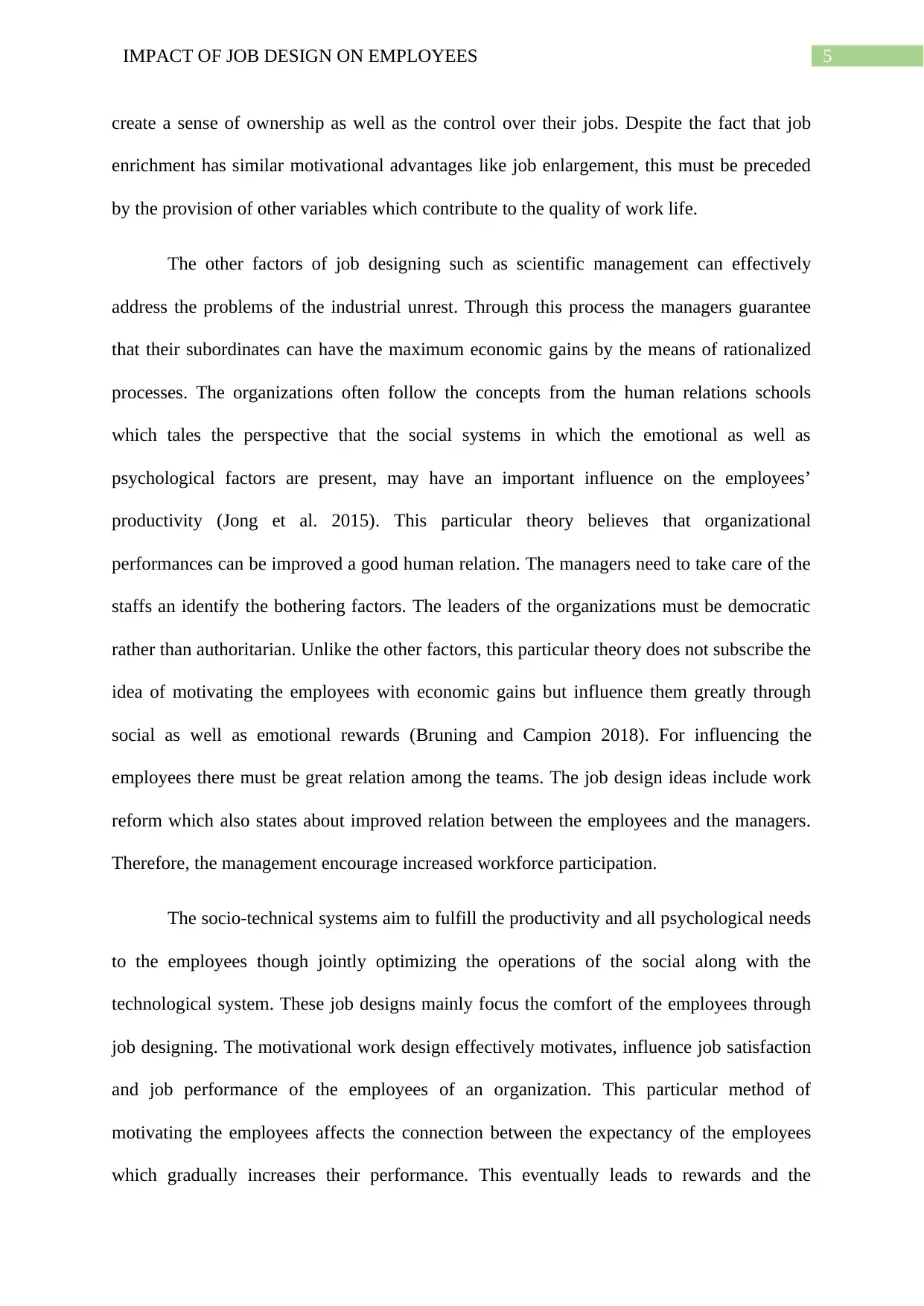
5IMPACT OF JOB DESIGN ON EMPLOYEES
create a sense of ownership as well as the control over their jobs. Despite the fact that job
enrichment has similar motivational advantages like job enlargement, this must be preceded
by the provision of other variables which contribute to the quality of work life.
The other factors of job designing such as scientific management can effectively
address the problems of the industrial unrest. Through this process the managers guarantee
that their subordinates can have the maximum economic gains by the means of rationalized
processes. The organizations often follow the concepts from the human relations schools
which tales the perspective that the social systems in which the emotional as well as
psychological factors are present, may have an important influence on the employees’
productivity (Jong et al. 2015). This particular theory believes that organizational
performances can be improved a good human relation. The managers need to take care of the
staffs an identify the bothering factors. The leaders of the organizations must be democratic
rather than authoritarian. Unlike the other factors, this particular theory does not subscribe the
idea of motivating the employees with economic gains but influence them greatly through
social as well as emotional rewards (Bruning and Campion 2018). For influencing the
employees there must be great relation among the teams. The job design ideas include work
reform which also states about improved relation between the employees and the managers.
Therefore, the management encourage increased workforce participation.
The socio-technical systems aim to fulfill the productivity and all psychological needs
to the employees though jointly optimizing the operations of the social along with the
technological system. These job designs mainly focus the comfort of the employees through
job designing. The motivational work design effectively motivates, influence job satisfaction
and job performance of the employees of an organization. This particular method of
motivating the employees affects the connection between the expectancy of the employees
which gradually increases their performance. This eventually leads to rewards and the
create a sense of ownership as well as the control over their jobs. Despite the fact that job
enrichment has similar motivational advantages like job enlargement, this must be preceded
by the provision of other variables which contribute to the quality of work life.
The other factors of job designing such as scientific management can effectively
address the problems of the industrial unrest. Through this process the managers guarantee
that their subordinates can have the maximum economic gains by the means of rationalized
processes. The organizations often follow the concepts from the human relations schools
which tales the perspective that the social systems in which the emotional as well as
psychological factors are present, may have an important influence on the employees’
productivity (Jong et al. 2015). This particular theory believes that organizational
performances can be improved a good human relation. The managers need to take care of the
staffs an identify the bothering factors. The leaders of the organizations must be democratic
rather than authoritarian. Unlike the other factors, this particular theory does not subscribe the
idea of motivating the employees with economic gains but influence them greatly through
social as well as emotional rewards (Bruning and Campion 2018). For influencing the
employees there must be great relation among the teams. The job design ideas include work
reform which also states about improved relation between the employees and the managers.
Therefore, the management encourage increased workforce participation.
The socio-technical systems aim to fulfill the productivity and all psychological needs
to the employees though jointly optimizing the operations of the social along with the
technological system. These job designs mainly focus the comfort of the employees through
job designing. The motivational work design effectively motivates, influence job satisfaction
and job performance of the employees of an organization. This particular method of
motivating the employees affects the connection between the expectancy of the employees
which gradually increases their performance. This eventually leads to rewards and the
⊘ This is a preview!⊘
Do you want full access?
Subscribe today to unlock all pages.

Trusted by 1+ million students worldwide
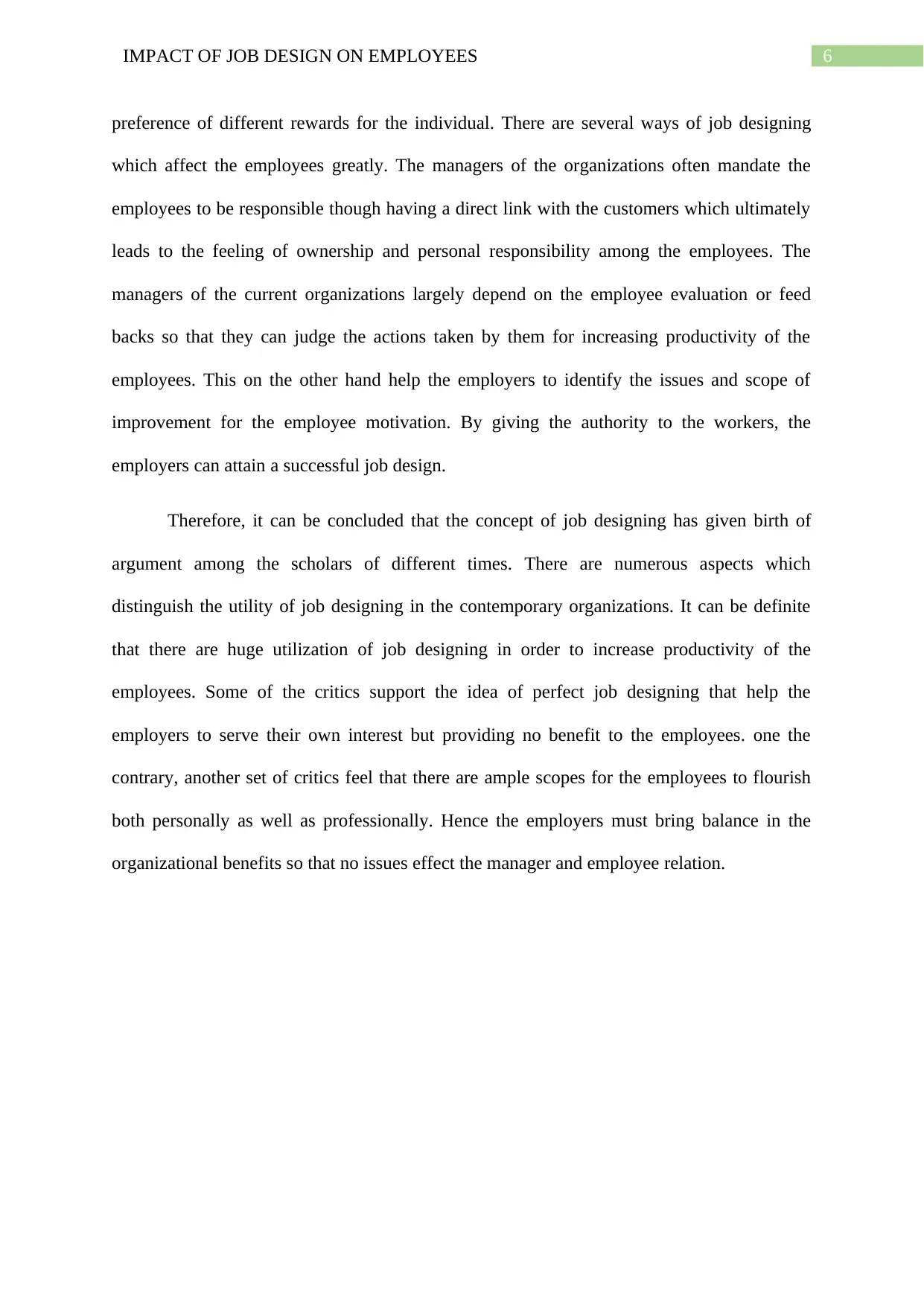
6IMPACT OF JOB DESIGN ON EMPLOYEES
preference of different rewards for the individual. There are several ways of job designing
which affect the employees greatly. The managers of the organizations often mandate the
employees to be responsible though having a direct link with the customers which ultimately
leads to the feeling of ownership and personal responsibility among the employees. The
managers of the current organizations largely depend on the employee evaluation or feed
backs so that they can judge the actions taken by them for increasing productivity of the
employees. This on the other hand help the employers to identify the issues and scope of
improvement for the employee motivation. By giving the authority to the workers, the
employers can attain a successful job design.
Therefore, it can be concluded that the concept of job designing has given birth of
argument among the scholars of different times. There are numerous aspects which
distinguish the utility of job designing in the contemporary organizations. It can be definite
that there are huge utilization of job designing in order to increase productivity of the
employees. Some of the critics support the idea of perfect job designing that help the
employers to serve their own interest but providing no benefit to the employees. one the
contrary, another set of critics feel that there are ample scopes for the employees to flourish
both personally as well as professionally. Hence the employers must bring balance in the
organizational benefits so that no issues effect the manager and employee relation.
preference of different rewards for the individual. There are several ways of job designing
which affect the employees greatly. The managers of the organizations often mandate the
employees to be responsible though having a direct link with the customers which ultimately
leads to the feeling of ownership and personal responsibility among the employees. The
managers of the current organizations largely depend on the employee evaluation or feed
backs so that they can judge the actions taken by them for increasing productivity of the
employees. This on the other hand help the employers to identify the issues and scope of
improvement for the employee motivation. By giving the authority to the workers, the
employers can attain a successful job design.
Therefore, it can be concluded that the concept of job designing has given birth of
argument among the scholars of different times. There are numerous aspects which
distinguish the utility of job designing in the contemporary organizations. It can be definite
that there are huge utilization of job designing in order to increase productivity of the
employees. Some of the critics support the idea of perfect job designing that help the
employers to serve their own interest but providing no benefit to the employees. one the
contrary, another set of critics feel that there are ample scopes for the employees to flourish
both personally as well as professionally. Hence the employers must bring balance in the
organizational benefits so that no issues effect the manager and employee relation.
Paraphrase This Document
Need a fresh take? Get an instant paraphrase of this document with our AI Paraphraser
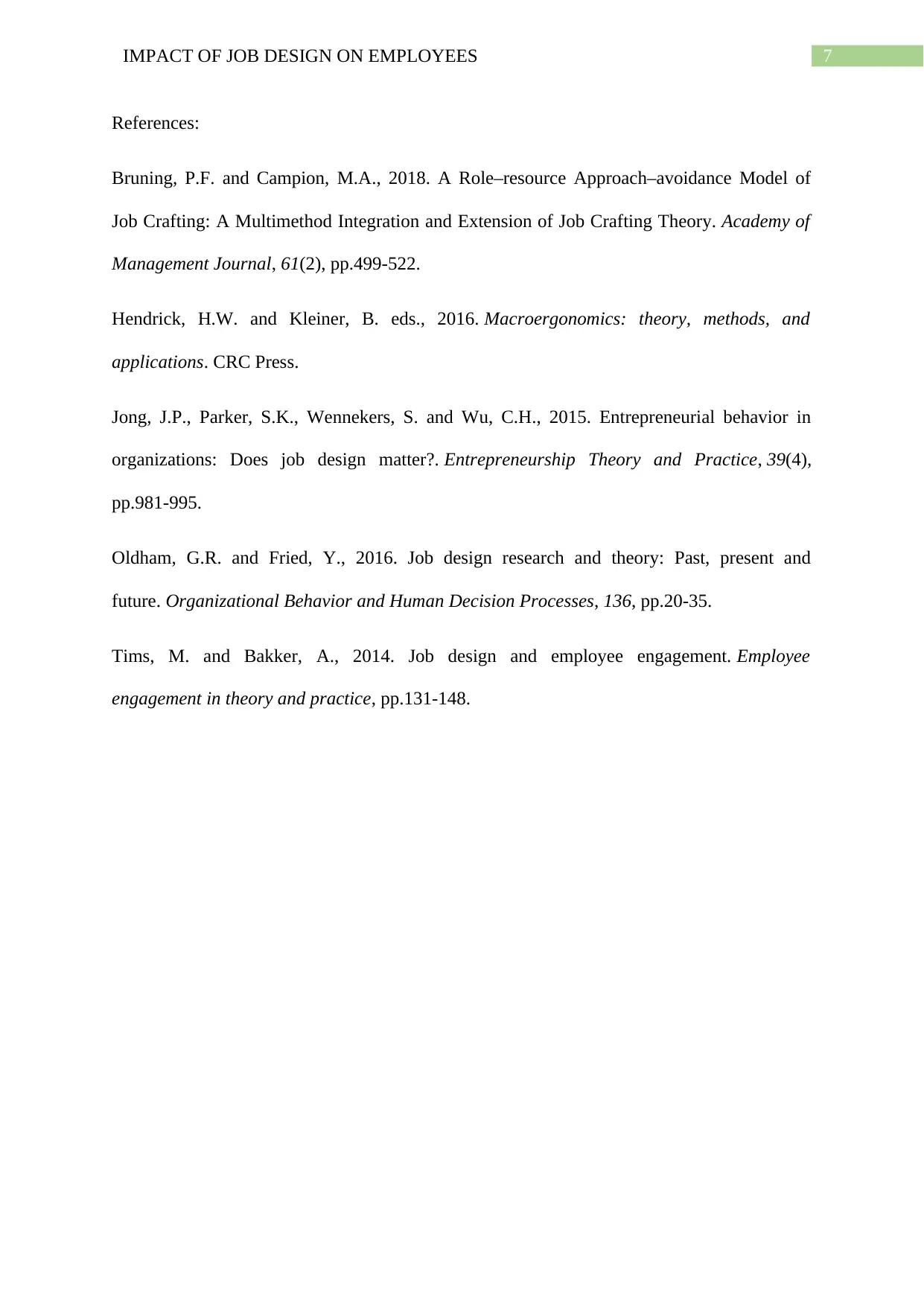
7IMPACT OF JOB DESIGN ON EMPLOYEES
References:
Bruning, P.F. and Campion, M.A., 2018. A Role–resource Approach–avoidance Model of
Job Crafting: A Multimethod Integration and Extension of Job Crafting Theory. Academy of
Management Journal, 61(2), pp.499-522.
Hendrick, H.W. and Kleiner, B. eds., 2016. Macroergonomics: theory, methods, and
applications. CRC Press.
Jong, J.P., Parker, S.K., Wennekers, S. and Wu, C.H., 2015. Entrepreneurial behavior in
organizations: Does job design matter?. Entrepreneurship Theory and Practice, 39(4),
pp.981-995.
Oldham, G.R. and Fried, Y., 2016. Job design research and theory: Past, present and
future. Organizational Behavior and Human Decision Processes, 136, pp.20-35.
Tims, M. and Bakker, A., 2014. Job design and employee engagement. Employee
engagement in theory and practice, pp.131-148.
References:
Bruning, P.F. and Campion, M.A., 2018. A Role–resource Approach–avoidance Model of
Job Crafting: A Multimethod Integration and Extension of Job Crafting Theory. Academy of
Management Journal, 61(2), pp.499-522.
Hendrick, H.W. and Kleiner, B. eds., 2016. Macroergonomics: theory, methods, and
applications. CRC Press.
Jong, J.P., Parker, S.K., Wennekers, S. and Wu, C.H., 2015. Entrepreneurial behavior in
organizations: Does job design matter?. Entrepreneurship Theory and Practice, 39(4),
pp.981-995.
Oldham, G.R. and Fried, Y., 2016. Job design research and theory: Past, present and
future. Organizational Behavior and Human Decision Processes, 136, pp.20-35.
Tims, M. and Bakker, A., 2014. Job design and employee engagement. Employee
engagement in theory and practice, pp.131-148.
1 out of 8
Related Documents
Your All-in-One AI-Powered Toolkit for Academic Success.
+13062052269
info@desklib.com
Available 24*7 on WhatsApp / Email
![[object Object]](/_next/static/media/star-bottom.7253800d.svg)
Unlock your academic potential
Copyright © 2020–2025 A2Z Services. All Rights Reserved. Developed and managed by ZUCOL.





